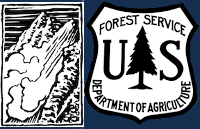The snowpack on Mt Ellis consists of a variety of faceted layers. Some are more dense than others, but the fact is if this slope gets a load it will likely produce avalanches. Photo: GNFAC
11-12
Surface hoar has been found in many areas in the northern Gallatin Range. Photo: Alex Marienthal
Forecast link: GNFAC Avalanche Forecast for Sun Dec 11, 2011
Forecast link: GNFAC Avalanche Forecast for Sun Dec 11, 2011
GNFAC Avalanche Forecast for Sat Dec 10, 2011
The Bridger, Gallatin and Madison Ranges, the Lionhead area near West Yellowstone and mountains around Cooke City:
GNFAC Avalanche Advisory for Fri Dec 9, 2011
The Bridger, Gallatin and Madison Ranges, the Lionhead area near West Yellowstone and mountains around Cooke City:
This natural avalanche occured near Cooke City on a NE facing slope near 9100 ft. This avalanche shows three things: 1)Cornices near the ridgetop indicate wind loading. 2)Weak facets near the ground have no problem fracturing across tree covered slopes. 3)If avalanches are occurring naturally, then they can surely be triggered by a skier or rider. Photo: B. Fredlund
This is the track and runout from an avalanche triggered by the Moonlight Basin Ski Patrol on a heavily wind loaded slope. Being caught in an early season slide is serious and likely to cause serious trauma. Photo: GNFAC
This avalanche was triggered by explosives by the Moonlight Basin Ski Patrol; however, this slope was heavily wind loaded and could have easily been triggered by a skier or rider. The snowpack is thin and weak with very large facets sitting under a fresh wind slab. This is a classic recipe for an avalanche. See a snowpit from the adjacent slope at: http://bit.ly/tL6j78 Also, see a video: http://bit.ly/vyZgut Photo: GNFAC
Northern Madison, 2011-12-08
GNFAC Avalanche Advisory for Thu Dec 8, 2011
The Bridger, Gallatin and Madison Ranges, the Lionhead area near West Yellowstone and mountains around Cooke City:
The snowpack is relatively simple. Generally you can find two basic situations:
